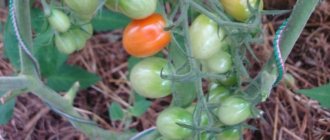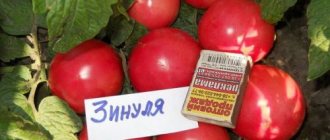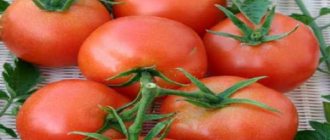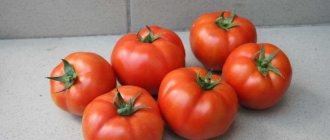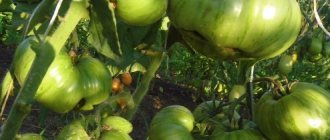Unusual tomatoes have become fashionable. If you read the description of this Orange Strawberry tomato variety on the package with seeds, you can say that it is perfect for growing in central Russia, as it is completely unpretentious and resistant to temperature fluctuations, and is not afraid of either drought or frost.
The name came about due to its shape and taste, reminiscent of garden strawberries. When tomatoes hang on a branch in clusters, you might think that they are not tomatoes, but orange strawberries. Country of origin: Germany. The variety was bred and tested a long time ago.
general information
The Orange Strawberry tomato variety is popular among tomato lovers. On forums and websites about tomatoes there are only admiring reviews about it. The tomato has been grown for a long time: avid summer residents and veteran gardeners have it in their arsenal, sharing seeds with neighbors and friends. They protected and preserved the delicious orange giant in every possible way for decades and were proud of it.
The variety was given a second life by now popular online stores and private farms selling “their own” seeds. Some of them got confused themselves and confused buyers. Now lovers and even sellers confuse the two varieties of “orange strawberry” and the “German orange strawberry” tomato.
No one can say where the name “Orange Strawberry” came from; 30 years ago there was no such variety, but there were other names for a similar species. Gardeners themselves became breeders: by keeping the best specimens for seeds, they achieved the best qualities of this species, and those who sell seeds developed an improved variety and gave it a new name.
Reviews
Milana:
“I choose exotic varieties of tomatoes that can truly surprise. In fact, I consider myself a gourmet, so I give preference only to appropriate vegetable crops. Orange strawberries are one of the best exotic tomatoes, but they still require specific care and the mandatory use of fertilizers. The gardener’s results will be rewarded with a rich and impeccably tasty harvest.”
Alexei:
“Before, I only grew ordinary tomatoes, but they became boring. Now I have chosen the Orange Strawberry variety. I grew it only last year, but the process of growing and caring for it, and the resulting harvest left only the best impressions. I plan to grow Orange Strawberry tomatoes again.”
Characteristics and description
Let's take a closer look at Orange Strawberry:
- It belongs to the indeterminate type, that is, it is a vine that will grow indefinitely, and growth depends on the possibility of the greenhouse. According to some reports, it grows up to four meters.
- The average ripening period, that is, from germination to the first harvest, is 100–110 days.
- Suitable for growing in greenhouses and open ground under cover.
- It bears 4–6 large fruits in a cluster, orange in color from 300 g to 700 g, but there is information that in the greenhouse they received fruits of 1 kg, however, 1–2 pieces were formed in a cluster.
- Extended fruiting, in good greenhouses it bears fruit until October.
- The fruits do not crack on the hand.
- Requires good support for the trunk and garters of the hands.
- Sets fruit during high temperatures.
- High-yielding - up to 6 kg from one bush you can harvest delicious salad tomatoes.
- Can be stored for no more than two weeks when ripe.
- Transportation is possible if you place the tomatoes in one row so that they do not touch each other.
Detailed description of the variety
Tomato of German selection Orange strawberry belongs to the indeterminate species. It is grown by closed and open methods. On unprotected soil it grows to a height of 1.8 m; in a greenhouse without growth correction it can reach 3.5 m. The top is pinched according to the height of the trellis. Tomato of unlimited growth, large-fruited, generative type. Shoot formation is insignificant, the bush is formed by two trunks, the main one and the stepson of the first order, the remaining side shoots are removed as they grow.
The Orange strawberry variety is a mid-late variety; the first ripe fruits are collected 110 days after the seedlings are placed in the garden. In temperate climates, the Orange strawberry tomato is cultivated using the closed method, in the South in open ground. The fruiting of the variety is extended, the tomatoes ripen unevenly on the bunch. The culture produces fruits of the same size from the first to the last circle.
The tomato is adapted to the weather conditions of most regions of Russia and tolerates low temperatures and drought well. Photosynthesis requires excess ultraviolet radiation; in the shade, growth slows down and the color of tomatoes becomes dull. When growing the Orange strawberry variety in greenhouse structures, care must be taken to install phytolamps. The plant must be illuminated for at least 16 hours.
External characteristics of the bush:
- The stems are thick, powerful, woody. The structure is fibrous, durable. The edge is small, thick, hard, the stems are gray with a green tint.
- Tomato leaves are opposite, the internodes are short. The leaf blade is narrow, long and dark green. The surface is finely pubescent, corrugated, the edges are coarsely toothed.
- The root system is powerful, overgrown, and superficial.
- Fruit racemes are articulated, of medium length, filled with 4–6 ovaries. Place a brush after 8 sheets, subsequent ones after 4.
- The tomato blooms with single simple dark yellow flowers. The flowers are bisexual, self-pollinating, and 100% produce ovaries.
Important! To obtain large-sized fruits, the plant is unloaded, leaving no more than 7 clusters on one shoot.
In warm climates, tomatoes ripen completely before frost sets in. In the central part of Russia, if the crop is grown in an unprotected area, the harvest from the last clusters is harvested at the stage of milky ripeness. The tomato variety Orange Strawberry ripens safely with sufficient light and does not differ in color and taste from naturally ripened tomatoes.
Description of fruits
The photo shows a heart-shaped Orange Strawberry tomato; according to reviews from vegetable growers, round tomatoes can also be found on the same plant. This can be attributed to the characteristics of the variety, and not to its shortcomings. Description of fruits:
- the main part of the tomatoes resembles garden strawberries in shape, hence the corresponding name, fruit weight is 400–600 g, in greenhouses up to 900 g;
- the color is bright yellow with a red tint, monochromatic;
- the peel is thin, dense, not prone to cracking, and tolerates transportation well;
- the surface is glossy, ribbed at the stalk;
- the pulp is juicy, oily, dark yellow in color, without voids and white areas, contains 4 seed chambers, few seeds.
The Orange Strawberry tomato is a table variety. It has a pronounced aroma, sweet fruity taste, and the acid concentration is minimal. The fruits contain carotene and, thanks to an enzyme, have a color unusual for the crop. Tomato Orange strawberries can be consumed without restriction by children and people with an allergic reaction to red-fruited varieties.
The fruits are universally used; they are processed into juice, puree, consumed fresh, and used for pickling.
Resistance to diseases and pests
Judging by the reviews and photos of the yield in September and October, the “Orange Strawberry” tomato is practically not susceptible to disease if you follow simple rules and prevention.
- Before planting, treat the seeds in a solution of potassium permanganate or phytosporin.
- Spray the seedlings regularly once every 2 weeks with antifungal and antiviral agents: one of the modern and safest ones is “phytosporin”.
- Ventilate the room after watering.
- Do not thicken the plantings: plant tall varieties in the greenhouse no more than 3 pieces per 1 square meter, remove leaves from the bush in a timely manner.
During fruiting, you should tear off all the leaves up to the brush on which all the ovaries have formed. This is done to ensure that all efforts go towards the formation of the harvest. It is important to follow the sequence: remove no more than one leaf per week.
Advantages and disadvantages, reviews from beginners and experienced gardeners
It is known that a tomato is not a vegetable at all, but a large, slightly sour salad berry. The fiery tomato confirms this title better than all other varieties. The tomato is characterized by a heart-shaped, slightly elongated berry shape. In addition to its unusual appearance, the tomato attracts gardeners with the following advantages:
- The yield is above average, up to 6.5 kg per bush, and even this figure can be increased with special fertilizing.
- Tomatoes ripen unevenly, ensuring an even supply of fresh tomatoes to the table.
- Tomato is not afraid of frost and persistent heat.
- You can pick unripe fruits, placing them in boxes for storage and ripening.
- Vitamin composition, bright taste.
However, there are also disadvantages:
- The tomato is growing too much and requires constant monitoring.
- The seed chambers are almost empty.
- The fertility of plantings depends on the illumination of the area.
Reviews:
- There are a lot of large-fruited tomatoes, but Orange strawberries develop evenly, all rows of ovaries form tomatoes of the same size. If necessary, you can leave the bush higher, the harvest will be richer, but it is also more difficult to care for long stems. Germination rate 100% (Oleg, Arkhangelsk region)
- The taste is reminiscent of fruit, the flesh is dense and oily. There are round tomatoes, but the taste and pulp are the same as heart-shaped ones (Irina, Penza).
Advantages and disadvantages
Having familiarized yourself with the “Orange Strawberry” tomato, the variety description of which is presented above, you can highlight its pros and cons.
Pros:
- Proven productive variety.
- The fruits are orange: they contain a high content of the substance “beta-carotene” - the “elixir of youth”, which is a powerful antioxidant. Thanks to their color, the fruits are safe for people with allergies.
- Tomatoes have a low acid content, so they can be consumed by people with gastrointestinal diseases.
- Of all the yellow-fruited varieties, this is the most delicious variety: a hint of fruit and an oily pulp.
- They do not crack in high humidity, completely set in heat, and are not susceptible to disease.
- Great raw, but can also be pureed and juiced.
Minuses:
Even with a stretch, no one could provide any downsides.
Therefore, the variety is worthy of being grown.
Description of the tomato variety Orange Strawberry and its yield
Orange strawberry is a tomato brought to us from Europe. It is one of the non-hybrid plants that Germany is proud of. Bred by German breeders 50 years ago. The bushes do not cause trouble when growing, have an original taste and have decent yield.
The seeds of the Orange Strawberry tomato variety are passed from one gardener to another, so it is resistant to most nightshade diseases. The vegetable also tolerates the effects of chemicals well. Over the years of cultivation, the tomato has acquired a reputation as an unpretentious fruit that you will want to plant on your plot next year, since the reviews about it are only positive.
What is Orange Strawberry?
The description of the variety is as follows. Tomatoes of the German strawberry variety are tall plants and sometimes reach 2-3 m. The bushes have expressive bright orange fruits that resemble a heart, around which narrow green leaves grow. Depending on the seeds purchased, the German orange strawberry tomato can be not only heart-shaped, but also cone-shaped.
It attracts with its unusual appearance and taste, the characteristics of which delight most lovers of these fruits. German strawberries are juicy, fleshy tomatoes with a sweet and sour flavor.
When compared with other varieties, the fruits are large (400-600 g), and there are almost no seeds inside. German orange strawberries bear 6-10 fruits. Up to 8 kg is harvested from 1 bush, so the yield is considered average. The plant is unpretentious and grows well in open ground and in greenhouse conditions. Fruiting is long: from July to the end of October.
Positive and negative aspects of the variety
The Orange Strawberry tomato has earned a positive reputation among most gardeners, since it has certain advantages over other varieties.
- unpretentiousness;
- early ripening;
- disease resistance;
- mass ripening of fruits;
- a shape and original taste that is unusual for many regions.
There are also small disadvantages to the variety: the German orange strawberry tomato is a voluminous and tall plant. If you plant tomatoes in open soil, you can do without pinching. But this variety of tomatoes is very dependent on feeding. To avoid a decrease in yield when growing on poor soils, it is advisable to apply fertilizers.
Preparing the soil for planting
To grow tomatoes from seeds and reap a good harvest, you need to properly prepare the soil. Experienced gardeners recommend planting seeds in self-prepared soil, consisting of loamy soil with the addition of compost or humus.
To make the soil more loose, sawdust should be added to it. The simplest option for growing seedlings of the German orange strawberry variety is peat tablets, which can contain 3-5 seeds. The convenience of such tablets is that there is no need to pick seedlings.
Also known as Orange Strawberry, this variety is almost immune to the diseases that nightshade plants are prone to. But this does not mean that it does not need to be looked after.
For prevention, before planting a plant, it is advisable to treat the soil with warm water with the addition of potassium permanganate, and in case of mass manifestations of late blight, spray the bushes with preparations that contain copper.
The most common pests that threaten the fruits and green leaves of the plant are whiteflies, spider mites and thrips. You can destroy them by sprinkling the bushes with a decoction of celandine or with chemicals intended for processing tomatoes.
Features of cultivation
Orange Strawberry tomatoes do not require special growing conditions.
The variety belongs to the mid-season type, so it should be sown no earlier than March, calculating the dates for your region.
Planting seedlings in the ground for the middle zone - no earlier than mid-May, when the soil warms up to 16 °C.
After sowing the seeds, remove the container to a warm place, not lower than 25 °C, and as soon as the seeds hatch, move them to the light and maintain the temperature at 15–16 °C for 7 days, then increase the temperature to 20–22 °C.
When the first two leaves appear, transplant the seedlings into larger boxes or separate containers, not forgetting to feed them with superphosphate and potash fertilizers.
When picking, remove weak seedlings immediately, don’t be sorry! And don’t take seedlings from your neighbors, as they most often give you the most inconspicuous, unnecessary leftovers. Do you need it?!
In indeterminate varieties, the first flower cluster appears no earlier than the eighth leaf, so the main task is to prevent the seedlings from stretching.
During this period, create at least 16 hours of daylight using fluorescent lamps or “phytolamps”.
To enhance root growth, plant in high pots, and as the bush grows, add soil. The land is also important: it must be fertile and neutralized.
Plant in pre-prepared holes: 1 liter of sifted ash, 1 liter of humus, two spoons of superphosphate. Water the hole well and sprinkle mulch on top.
Do not fertilize or treat plants for two weeks.
Features of agricultural technology
Seedlings require additional lighting if the duration of sunlight per day is less than 7 hours. Also, after planting in a greenhouse, the bushes require a lot of light. If you neglect this issue, the bushes will weaken and bear less quality fruit. The photo shows a lighting system suitable for greenhouse beds. In an open garden, the beds should also be distributed correctly so that shadows from trees or buildings do not interfere.
At the initial stage of development, a tomato requires fertilizer with calcium; later the concentration can be reduced to a minimum. Next, you will need complex and mineral supplements. You can water the plants no more than 2 times a week. When it comes to outdoor garden beds, you can rely on the strength of precipitation. During drought, it is recommended to monitor the condition of the soil and moisten it in time.
Agronomists fight pests with standard spraying and mechanical removal. The plant is resistant, but with rare ventilation and too dense planting, gray rot may appear. Improper watering will also lead to rot, so the drip method should be preferred.
The tomato is immune to disease and highly resistant to stressful weather changes.
How to grow seedlings
Sowing work is carried out at the end of March, 2 months before transplanting into the ground. Tomatoes are grown only by seedlings.
Seed preparation
Varietal crops provide an opportunity for independent collection of seed material. But, as a rule, such planting material requires proper disinfection.
Initially, seeds are rejected, disposing of distorted and dark-colored ones. Then they are checked for emptiness inside. To do this, dissolve 1 teaspoon of salt in a glass of water and place the grains in the solution for 10 minutes.
Those that float to the surface will not sprout, so they are disposed of. Disinfection is carried out in a weak solution of potassium permanganate for 20 minutes. After this, rinse with running water and dry.
Reference . Instead of manganese solution, you can use 2% hydrogen peroxide.
To increase the germination rate, seeds are germinated on damp gauze. The grains are laid out on gauze, moistened with warm water and left in a dark place for 2-3 days until sprouts appear. As the gauze dries, sprinkle with warm water.
Container and soil
For seed germination, prepare nutritious soil from turf soil, sand, peat and wood ash in equal quantities. After thoroughly mixing all the components, the resulting mixture is poured with a hot solution of potassium permanganate or steamed in the oven at a temperature of 50 ° C for 15 minutes. Disinfection of the soil is necessary, otherwise pathogenic spores will destroy all plantings.
The disinfected soil is laid out in prepared containers, having previously made small holes at the bottom for drainage.
Reference . Drainage is necessary for the outflow of excess moisture.
You can plant in a common wooden box or use individual containers, for example, paper honeycombs, plastic cups and peat pots.
Sowing
The seed material is buried by 2 cm, leaving a distance between them of at least 1.5 cm. Sprinkled with peat, lightly compacted, watered with warm, settled water using a spray bottle and covered with film or glass to create greenhouse conditions. The seeded containers are left in a bright room at a temperature of 22 °C.
Caring for seedlings
As soon as the seedlings appear, the containers are immediately moved to the windowsill. Daylight for seedlings is provided at least 16 hours. With a lack of light, the sprouts will stretch and weaken. Therefore, you should take care of installing phytolamps in advance. It is not recommended to illuminate seedlings for more than 16 hours, since vital processes take place in the dark.
It should be watered as the top soil layer dries out with warm, settled water using a shallow watering can or a tablespoon along the edge of the containers. There is no need to flood the sprouts, otherwise you can provoke rotting of the young roots or the development of fungal diseases. After watering, the soil is loosened superficially so that the soil is better saturated with oxygen.
As soon as 3 true leaves are formed, the seedlings are picked, planted in separate containers, or left in a common container, but with a distance between seedlings of at least 15 cm. At this moment, the first fertilizing is applied in the form of a complete complex fertilizer. Fertilizing must be combined with watering.
2 weeks before planting in the ground, the seedlings are hardened off - taken outside in the daytime for 1 hour at a temperature of 16 °C. Gradually, the time spent outside is increased to 10 hours, while simultaneously reducing the night temperature in the room to 12 °C.
Tomato care
The yield of the German Orange Strawberry variety depends on the quality of care for it. Also, the taste and shape of the fruit may depend on the careful attitude towards this crop. If it is not sweet and small enough, then you need to reconsider the rules for growing it.
The correct temperature during cultivation on the windowsill affects the development of shoots that are prepared for transplanting into the ground. During seed germination, it is usually at least 22 degrees, and then make sure that the temperature is 17-20 degrees.
Feeding with various fertilizers at certain times. There are times when fertilizing should be applied: this is before planting, during the flowering period, and when the tomatoes begin to ripen. These should be both mineral and organic fertilizers purchased in the store. The soil must contain humus, manure, peat, and sand.
Loosening the soil and removing weeds. You need to do this once every two weeks, so the grass grows quickly and takes away nutrients from the tomatoes, preventing them from growing. And loosening and hilling the soil helps water and nutrients penetrate faster.
Plants may not have enough light. To do this, you need to tear off excess foliage and plant bushes further away from each other. Also, do not plant other tall plants nearby.
Pest control is very important for vegetable crops. It is necessary to prevent various bugs, mites, slugs, and butterflies from ruining the tomatoes. For prevention, periodically spray the bushes with various means that create uncomfortable conditions for uninvited guests.

